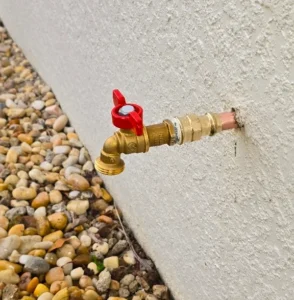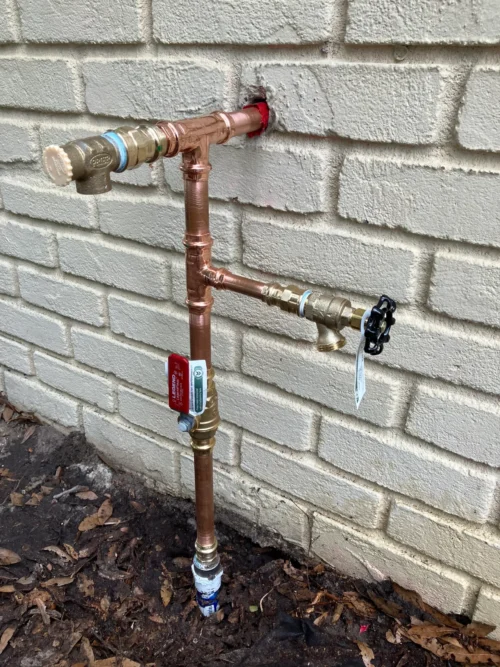Takeaways
- Proper hose bibb installation and material selection prevent leaks, frost damage, and costly repairs.
- Simple hose bibb repairs typically involve replacing washers or tightening packing nuts; sometimes full replacement is more cost-effective.
- Regular hose bibb maintenance and backflow prevention ensure long-term reliability and safe water delivery.
As your trusted local team at North Fort Myers Plumbing Inc., we often help homeowners tackle outdoor plumbing issues. One of the most overlooked yet essential components is the hose bibb—commonly known as the outdoor faucet. When installed correctly, it ensures seamless garden watering, pool filling, and seasonal maintenance. When it leaks or breaks, it can waste water, cause wall damage, and freeze in winter. In this guide, we explain everything you need to know about installing or repairing a hose bibb safely and efficiently.
🛠️ Hose Bibb Installation
Choose the Right Location and Shut Off Water
We always recommend choosing a wall location near your existing plumbing lines to keep the job simple. Before anything else, shut off your home’s water supply to avoid unwanted spray or mess. Once the water stops flowing, open the existing hose bibb or another faucet to relieve pressure. Choosing a slightly downward-facing spot helps ensure water drains properly after each use. This also reduces freeze risks and prolongs the life of your installation.
Select Quality Materials for Durability
Using the right materials makes all the difference for long-term performance. At North Fort Myers Plumbing, we install brass hose bibbs that resist rust and wear from Florida’s humid climate. For homes in frost-prone areas, we recommend frost-free sillcocks that prevent pipe bursts during winter. The Pacific Northwest National Laboratory advises installing frost-proof outdoor faucets and using insulation to prevent freeze-related damage. Each part, from connectors to screws, should be corrosion-resistant and plumbing-code compliant. This guarantees safer operation and fewer repairs down the line.
Prepare the Pipe and Use Proper Connectors

Before beginning any hose bibb or pipe installation, make sure to smooth all pipe edges using a deburring tool. Clean pipes ensure secure fittings and reduce the chance of leaks. Push-to-connect systems like SharkBite work well with copper, PEX, and CPVC pipes. We mark the insertion depth and push the fitting in until it locks in place. This eliminates the need for soldering or torches, which is safer and faster for most DIY homeowners. Secure all fittings with Teflon tape or plumber’s compound for added leak protection.
Mount the Hose Bibb Securely
Once everything connects properly, align and mount the hose bibb securely against the wall. Use appropriate screws and anchors based on the surface material—brick, wood, or vinyl. Make sure the spout angles slightly downward to encourage full drainage when not in use. Apply Teflon tape on any threaded joints and tighten using a wrench—just enough to form a seal. Over-tightening can crack fittings and lead to leaks or costly replacements.
Restore Water Supply and Check for Leaks
Turn the main water supply back on slowly and open the newly installed hose bibb. Watch the joint connections carefully as pressure builds and look for even the smallest drips. If a leak appears, gently tighten the connection until it stops. Run water for 30 to 60 seconds to flush out debris and verify a steady, even flow. If you notice recurring moisture or suspect hidden leaks within plumbing systems, consider a professional leak detection service.
🔧 Hose Bibb Repair (Leaking or Dripping Spigot)
Common Sources of Leaks
Most hose bibb leaks happen at the spout or handle due to worn parts. A faulty stem washer can let water drip constantly, even when turned off. Damage to the packing string under the handle can also cause moisture buildup around the stem. In some cases, the vacuum breaker may leak during use or when under back pressure. The U.S. eCFR mandates that outdoor faucets include proper backflow prevention, which helps reduce contamination risk. At North Fort Myers Plumbing, we always inspect the bibb carefully before deciding on a repair or full replacement.
Step-by-Step Repair Process
To begin a repair, shut off the home’s water supply and open the hose bibb to release pressure. Unscrew the handle and carefully remove the packing nut beneath it. Slide out the stem and inspect the washer at the tip—cracked or flattened washers must be replaced. Rewrap the stem with fresh packing string or replace the bonnet washer if it looks worn. Reassemble the unit and turn the water supply back on to check for improvement.
Quick Fixes Without Full Disassembly
Some minor leaks can be resolved without removing the entire stem. If water seeps around the handle, gently tighten the packing nut with a wrench. This often compresses the seal enough to stop small leaks. When the vacuum breaker leaks, remove it by hand, clean the threads, and install a new one. These quick fixes can save time and money while extending the life of your current fixture. If problems return, it may be time for full replacement.
When Full Replacement Becomes Necessary
If your hose bibb has visible rust, cracks, or damage to the body, replacement is the better option. Repairs won’t last if the internal threads or valve seat are compromised. In older homes or during remodel plumbing projects, compatible parts or replacement washers may be hard to source. When the cost of parts approaches the price of a new unit, we suggest installing a modern frost-proof sillcock. It provides better protection, improved efficiency, and a more reliable shutoff mechanism.
✅ When to Repair vs Replace
Repair Makes Sense When
- Leaks are isolated to the stem or handle
- The valve body remains in solid condition
- You can access replacement washers or parts
- Minor drips happen during use but stop afterward
- The unit is under 10 years old and has no corrosion
Replace if You Notice
- Continuous dripping even after replacing washers
- Rust, mineral buildup, or a cracked spout
- Leaks from multiple areas including the wall or flange
- Frost damage or water inside the wall cavity
- Loose or stripped threads that prevent hose connection
🎥 Expert Video Demonstrations
We often recommend that homeowners check out visual guides before attempting a DIY hose bibb project. SharkBite offers several excellent walkthroughs showing how to install a frost-free bibb with push-to-connect fittings. Their videos highlight real-world installations using copper, PEX, and CPVC piping. You’ll see the correct way to cut, mark, connect, and test fittings without needing solder or glue. Watching a few of these videos before getting started helps avoid costly mistakes.

Another helpful video focuses on repairing leaky hose bibbs using only basic tools. It shows how to swap out washers, packing nuts, and vacuum breakers without disassembling the full system.
These videos demonstrate proper wrench technique, sealing methods, and leak detection—all things we train our own team on. If you’re more of a visual learner, these videos are a perfect place to start. We’re happy to point you toward trusted resources when you give us a call.
🔍 Maintenance & Seasonal Tips
Regular maintenance goes a long way in keeping your hose bibb leak-free and reliable. We recommend inspecting outdoor spigots twice a year—once in spring and again in the fall. Look for signs of dripping, corrosion, or hard-to-turn handles. Clean off mineral buildup using vinegar and a cloth to maintain proper seal surfaces. Lubricate moving parts with food-grade silicone grease to reduce wear.
This table highlights outdoor temperature thresholds, winter preparations, and damage risk levels for hose bibbs. It adds clarity on when to act and what protective measures to use.
| Temperature Range (°F) | Recommended Action | Freeze Damage Risk |
|---|---|---|
| Above 32°F | Normal use; inspect for leaks and corrosion | Low |
| 28–32°F | Detach hoses; install insulated cover | Moderate |
| 20–28°F | Shut off & drain; faucet dripping or bleed valve | High |
| Below 20°F | Drain and leave open; ensure frost‑proof bibb installed | Very High |
As temperatures drop, it’s critical to disconnect all hoses from your bibbs. Leaving hoses attached traps water inside the pipe, which can freeze and crack fittings. Use insulated faucet covers or install frost-proof units for added winter protection. The PNNL Winter Weather Guide outlines steps like draining interior valves and using thermal sleeves to prevent freeze damage. Simple actions like these prevent thousands of dollars in damage and give peace of mind year-round.
FAQ
What is the average lifespan of a hose bibb?
A well-installed hose bibb made from brass or frost-free materials can last 10 to 20 years. Routine maintenance, such as seasonal draining and part replacement, helps extend this lifespan. Florida’s humid climate can cause faster wear on lower-quality bibbs. Keeping threads clean and using hose gaskets prevents excess strain on the unit. Regular inspection makes it easier to spot issues before they require full replacement.
Why does my hose bibb still drip after I shut it off?
Persistent dripping usually signals a worn stem washer or damaged valve seat inside the hose bibb. If the leak stops a few seconds after shutting off, residual water is likely draining, which is normal. A continuous drip means internal components are no longer sealing properly. Replacing the washer or packing nut usually solves the issue. If not, a full replacement may be necessary.
Are frost-free hose bibbs worth the upgrade in Florida?
Even in Southwest Florida, frost-free bibbs offer added protection during occasional cold snaps or unexpected drops in temperature. Homes near inland areas or with exposed exterior piping benefit the most from this upgrade. These bibbs reduce the risk of burst pipes by keeping the shutoff valve deeper inside the wall. They also come with backflow prevention and cleaner water delivery. We install frost-free models as a long-term investment in plumbing resilience.
Can I replace a hose bibb myself or should I hire a plumber?
DIY replacement is possible if you’re comfortable working with pipes and basic tools. However, small mistakes like overtightening, misalignment, or improper sealing often lead to bigger issues later. Hiring a professional ensures proper fitting, secure mounting, and compliance with local codes. The ASSE and UPC standards recommend anti-siphon features and lead-free components for safety. In most cases, a professional job saves you time, stress, and potential water damage.
- Addressing Low Water Pressure in Older Florida Homes: Diagnosis, Solutions, and When to Call a Plumber - December 11, 2025
- Chloramine in Lee County Water: Understanding Its Impact on Rubber Gaskets, Water Heater Elements, and Plumbing Lifespan. - December 4, 2025
- Plumbing Durability for SWFL Rental Properties: Choosing Fixtures and Systems That Withstand High-Occupancy Wear and Tear - November 25, 2025